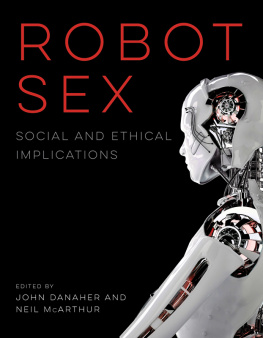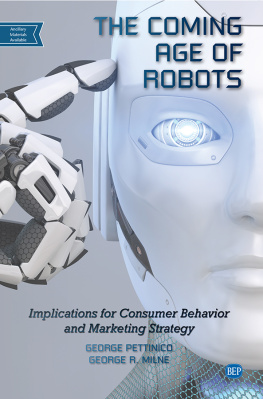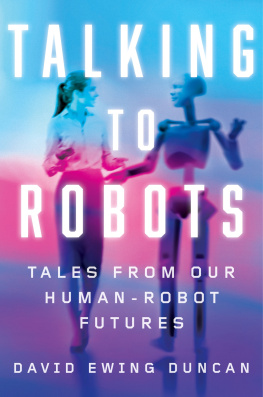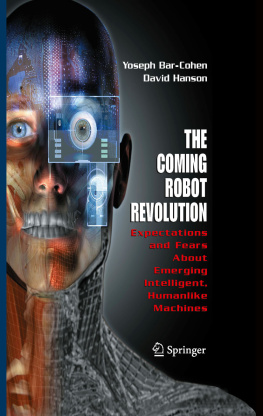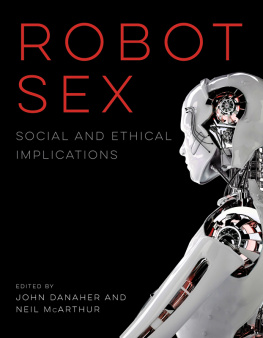
Robot Sex
Social and Ethical Implications
John Danaher and Neil McArthur
The MIT Press
Cambridge, Massachusetts
London, England
2017 Massachusetts Institute of Technology
All rights reserved. No part of this book may be reproduced in any form by any electronic or mechanical means (including photocopying, recording, or information storage and retrieval) without permission in writing from the publisher.
This book was set in ITC Stone Sans Std and ITC Stone Serif Std by Toppan Best-set Premedia Limited. Printed and bound in the United States of America.
Library of Congress Cataloging-in-Publication Data is available.
ISBN: 978-0-262-03668-9
eISBN 9780262341974
ePub Version 1.0
Acknowledgments
It is an old clich to say that books are never solo efforts, but that is truer in the present instance than in most. This book was not the product of one author in either conception or execution. We, the editors, would like to sincerely thank each of the contributors for dedicating their time and energy to their chapters. By adding a diversity of perspectives they have greatly enhanced the quality and depth of the insights that have been brought to bear on this topic. We would also like to thank the editors and reviewers at the MIT Press for their feedback and help at all stages of the production process.
John Danaher:I would like to thank my coeditor Neil McArthur for proposing the idea of this edited collection to me and for feedback on my draft chapters. I am grateful as well to my colleagues at Keele University and NUI Galway for helpful conversations and feedback about the ideas contained within this book. I would also like to thank my partner Aoife Lynch for her help and support. I know it hasnt always been easy putting up with my odd research interests and my propensity to discuss them at social functions, but you have always done so with remarkable patience and good humor.
Neil McArthur:Thanks are due to my coeditor, John Danaher, for feedback on various drafts of my chapter. My colleague Rhonda Martens and her students read an early version and invited me to discuss it in class. Markie Twist of the University of Wisconsin, Stout, invited me to present my ideas in a public lecture at her institution, and I benefited greatly from the discussion that followed.
I Introducing Robot Sex
Sexbots are coming. But many people consider the very idea of sex with a robot perverse or bizarre. The opening chapter, by Danaher, tries to explain what a sex robot is, whether any currently exist, and why this is a topic worth taking seriously right now. The second chapter, by Migotti and Wyatt, looks at the nature of sexual activity and asks whether it is possible to have sex with a robot. In the process of doing so, they argue that there is a distinct good involved in sexual activity as an exercise of shared agency.
1 Should We Be Thinking about Robot Sex?
John Danaher
The fourth skinjob is Pris. A basic pleasure modelthe standard item for military clubs in the outer colonies.
Blade Runner
1.1Introduction
There is a cave in the Swabian Alps in Germany. It is called the Hohle Fels (rough translation hollow rock). Archaeologists have been excavating it since the late 1800s and have discovered there a number of important artifacts from the Upper Paleolithic era. In June 2005, they announced a particularly interesting discovery. They announced that they had unearthed the worlds oldest dildo.
The object was 20 cm long and 3 cm wide. It was estimated to be 28,000 years old. It was made from highly polished stone. It was, as Professor Nicholas Conard of the dig team remarked, clearly recognizable as a phallic representation. The fact that its size and shape were reasonably lifelike led some to speculate that it may have been used for sexual stimulation and not just for religious or symbolic purposes.
Of course, we can never know for sure. The past is often unrecoverable. But artifacts for sexual stimulation have long been a staple in human life. Dildos have been found in ancient cultures in both the East and West. And the technology of sex has advanced over the centuries. In 1869, the American physician George Taylor invented the first steam-powered vibrator. It was used at the time as a treatment for women suffering from hysteria. The first electrical vibrator for consumer sale was produced by the company Hamilton Beach in 1902. Since the early part of the twentieth century there have been further developments in the technology of sex, from artificial vaginas to lifelike silicone dolls to teledildonics.
This book is about another development in the technology of sex, namely: the creation of advanced sex robots. It features papers from a diverse set of contributors, each of whom focuses on a different aspect of the philosophical, social, and ethical implications that might arise from the creation of such devices. The contributions are speculative and analytical in nature. They are intended to raise questions and provoke answers. Some do so by taking a strong view on the topic, but all are written in the shadow of an uncertain future.
I do not wish to recapitulate or summarize what the contributors have to say in this opening chapter. Instead, I want to set the stage for the remainder of the book by asking and answering a few preliminary questions: What are sex robots? Do any exist right now? Why should we care about their creation? I take each question in turn.
1.2What Are Sex Robots?
Robot has become a familiar term and robots have become a familiar concept. The term was first used in Karel apeks play R.U.R. (Rossums Universal Robots). apek used the term robot to describe an artificial humanoid being made from synthetic organic matter. The term was quickly adopted by scientists and science fiction writers, perhaps most famously by Isaac Asimov in his Robot series of short stories and novels. In the process, the concept evolved away from what apek originally intended. It was no longer used to describe humanoid artificial beings. It was, instead, used to describe virtually any embodied artificial being. The most common real-world examples of robots are to be found in industrial manufacturing processes. The International Federation of Robotics defines an industrial robot as an automatically controlled, reprogrammable, multipurpose, manipulator programmable in three or more axes, which may be either fixed in place or mobile for use in industrial automation applications.
Obviously, sex robots are not quite the same as industrial robots. In previous work I have proposed a definition of sex robot that brings us back a little bit closer to Capeks original intention. The definition holds that a sex robot is any artificial entity that is used for sexual purposes (i.e., for sexual stimulation and release) that meets the following three conditions:
Humanoid form, i.e., it is intended to represent (and is taken to represent) a human or human-like being in its appearance.
Human-like movement/behavior, i.e., it is intended to represent (and is taken to represent) a human or humanlike being in its behaviors and movements.
Some degree of artificial intelligence, i.e., it is capable of interpreting and responding to information in its environment. This may be minimal (e.g., simple preprogrammed behavioral responses) or more sophisticated (e.g., human-equivalent intelligence).
Defined in this manner, sex robots are different from existing sex toys and sex dolls. Most existing sex toys do not have a humanoid form. They are, typically, representations of discrete body parts or orifices. These partial representations may have some humanlike movement, but they do not have much in the way of artificial intelligence (although this is certainly changing with the rise of smart tech and the Internet of Things). Sex dolls, on the other hand, do have a humanoid form, but are passive, inanimate, and unintelligent. Sex robots have more going on.
Next page
